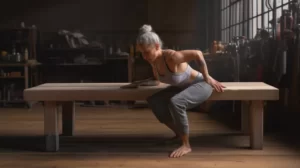Many people tend to overlook the importance of focusing on their lower body when exercising. They might lift weights or do cardio, but exercises for balance and leg strength often take a back seat. However, leg strength, endurance, and dynamic balance are crucial for overall wellness. They make you more stable, more balanced, and allow you to engage in activities like jogging, aerobics, basketball, hiking, Pilates, and even bowling without getting injured.
Getting Started with Rebounders
A mini trampoline, also known as a rebounder, is an excellent tool for developing stability through dynamic movement. Because the trampoline isn’t “fixed,” your body has to constantly adjust by engaging various muscles at different rates and intensities to maintain balance. This process helps in developing leg strength and endurance that you cannot achieve by lifting weights or working on a stable floor.
The key to being successful with these rebounder exercises is maintaining your balance while building your strength. Here are two suggestions to help you stay balanced:
- Hold your arms out extended in front of your chest as a counterbalance.
- Hold your arms up, with fingers behind your head, to remain vertically stable.
Now that you have these balance guidelines let’s dive into two rebounder squat exercises.
Exercise 1: Squat to Calf Raise
Start by standing on the rebounder, with your feet shoulder-width apart. Depending on your mobility and balance level, you can begin with your feet slightly wider. Once you have found a good balance width, follow these four steps:
- Squat down and let your weight sink into your heels.
- While in the squat position, raise up onto your toes and balance for a second.
- Stand up while remaining on the balls of your feet.
- Once you are vertical, go back to the flats of your feet and repeat.
Aim to complete 10 squat to calf raises to get started.
Exercise 2: Lateral Squats
This next squat exercise is a bit more challenging because it requires you to move laterally across the rebounder while squatting and jumping. But it’s a lot of fun, too!
Begin with one foot flat on the floor and the other flat on the rebounder. Once you have found a good balance width, follow these three steps:
- With both feet squared forward, squat down.
- Jump up and do a lateral shuffle to the other side of the rebounder.
- Squat down with feet flat on the floor and rebounder, on the opposite side, and repeat.
Try to complete 10 lateral squat lunges. Keep in mind that lunging right and then left equals one repetition.
Tip: If you find it challenging to maintain balance, swinging your arms while moving makes a significant difference.
More Benefits of Rebounding
In addition to toning and strengthening your lower body and improving your dynamic balance, rebounding has numerous other health benefits. According to Nasa’s Journal of Applied Physiology, rebounding is an effective and efficient exercise for improving cardiovascular health and building muscle strength.
Furthermore, it has been shown to aid in detoxifying the lymphatic system, which plays a crucial role in your immune system. Rebounding also places less stress on your joints than other high-impact exercises, making it an excellent workout option for people with joint issues or recovering from injuries.
Wrapping Up
In conclusion, incorporating rebounding into your workout routine is a fun and effective way to tone and strengthen your lower body, develop dynamic balance, and improve cardiovascular health. It’s suitable for almost everyone, and the variety of exercises you can perform on a rebounder ensures you’ll never get bored. So, why not give it a try and take your fitness journey to new heights!



